An In-Depth Analysis of Volcanic Rock and Its Impact


Intro
Volcanic rock, a product of the Earth’s molten core, is more than just a collection of hardened lava. It’s a testament to the dynamic processes that shape our planet. From the majestic formations like basalt columns to the intricate textures of pumice, volcanic rocks provide a window into the past, revealing secrets about our geological history. In this article, we will explore the formation, types, and the myriad roles volcanic rock plays in both geological frameworks and ecological systems.
As we traverse this intriguing landscape, our aim is to equip collectors, educators, and enthusiasts alike with not merely a understanding of the characteristics, but also with insight into the identification techniques and significance of these rocks. Whether you’re a seasoned collector or a curious novice, a solid grasp on volcanic rock can enrich your appreciation for both nature and science alike.
Featured Collectible of the Month
Overview
This month, we are highlighting obsidian, one of the most fascinating volcanic rocks available to collectors. Obsidian is formed when lava cools rapidly, preventing the growth of crystalline structure. This results in a glassy texture, often featuring shimmering inclusions or even translucent qualities against the light. Not only is it admired for its unique beauty, but it also has historical importance, as ancient civilizations utilized this material to craft tools, weapons, and decorative objects.
Historical Significance
Obsidian’s allure stretches back through time. In the ancient world, cultures employed it as a cutting tool. For instance, the Aztecs were skilled at crafting sharp blades from this volcanic glass. Not just a practical item, these artifacts carried cultural significance in rituals and trade. Collectors today seek remnants of these civilizations, valuing not just the material's beauty but its narrative. To hold an artifact made of obsidian is to touch a piece of history.
"Obsidian is not just rock; it’s a legacy etched in mineral form."
Identification Techniques
Visual Characteristics
To confidently identify volcanic rock, one needs to observe its unique visual features. Here are some key identifiers for various types of volcanic rock:
- Obsidian: Glassy texture, typically black or dark green; specimen might show a translucent edge.
- Pumice: Light and full of holes or vesicles; often floats in water due to low density.
- Basalt: Dense, fine-grained texture, usually dark in color but can appear grey or brown.
- Tuff: Composed of volcanic ash; often has a more porous structure, displaying grains of minerals and rocks.
Resources for Identification
Identifying volcanic rock can be tricky, but several resources can help:
- Wikipedia on Volcanic Rock
- Britannica – Igneous Rock
- Online forums on platforms like Reddit can offer real-time advice from enthusiasts and experts.
In summary, understanding volcanic rock is a blend of recognizing its forms, knowing its history, and appreciating its role in our ecosystem. As we delve deeper into the world of volcanic rock, we uncover not just geological formations but also the stories embedded within them.
Preface to Volcanic Rock
Volcanic rock, as an area of geological study, beckons those who want to understand the fiery heart of our planet. It plays a pivotal role not only in the creation of new landforms, but also in the ongoing dialogue between the Earth's interior processes and its surface environment. Knowing about volcanic rocks offers invaluable insights into how our planet evolves. In this article, we will embark on a thorough examination of volcanic rocks, demystifying their importance through historical context, formation processes, types, and significant roles in both ecological and human context.
Defining Volcanic Rock
Volcanic rock primarily forms from the cooling and solidification of magma that erupts from volcanic vents. Though the term might seem straightforward, the complexities behind the formation of these rocks are anything but simple. Generally speaking, volcanic rocks are categorized as igneous due to their origins from molten material. Depending on the speed at which the lava cools, we get various types of volcanic rocks. For instance, fluid lava, when quickly cooled, can yield basalt—dark and dense. Conversely, a slower cooling process can yield lighter-colored rocks such as rhyolite.
Furthermore, volcanic rocks vary in structure and texture. When lava cools and solidifies quickly upon contact with air or water, it might form a glassy texture, like obsidian, which lacks a crystalline structure. In contrast, rocks that cool slowly under ground create larger crystals, showcasing the diverse beauty of volcanic formations. Through understanding these aspects, enthusiasts and scholars alike can better appreciate the diversity and complexity of volcanic rocks.
Historical Context of Volcanic Studies
The study of volcanic rock is embedded deeply in the annals of geoscience. Understanding the history of volcanic studiesoffers crucial perspectives on how our comprehension of volcanism has evolved. Early societies viewed volcanoes as the tempers of gods, often associating eruptions with doom and destruction. Yet, over centuries, scientists like Pliny the Elder meticulously cataloged volcanic activity, laying groundwork that would later evolve into a scientific understanding.
The real turning point in volcanic studies came during the late 18th century and early 19th century with the advent of modern geology. Pioneers such as James Hutton and Charles Lyell challenged prevailing views, laying the foundation on which our understanding of geological timescales would build. By examining processes like uplift and erosion, they began to paint a comprehensive picture of how volcanic activity shapes the Earth's crust.
Today, advanced technologies have enabled a deeper exploration into volcanic behaviors. Satellite imagery and remote sensing allow for real-time monitoring of volcanic eruptions, aiding in both research and disaster management. Through examining the historical context of volcanic studies, one can grasp the transformative journey of this field and its ongoing relevance in understanding Earth's ever-changing landscape.
Formation Processes of Volcanic Rock
Understanding the formation processes of volcanic rock is crucial not just for rock and fossil collectors but for those who seek to grasp the intricate workings of our planet. The birth of these rocks tells a story about the Earth’s interior, revealing insights into geophysical dynamics, element compositions, and even the history of the atmosphere. Grasping these processes gives a clearer view of how volcanic activity shapes landscapes and ecosystems.
Magma Generation and Evolution
Magma originates deep within the Earth’s mantle, typically at depths of about 20 to 300 kilometers. The process of magma generation usually involves melting of the mantle rock triggered by a combination of temperature, pressure, and the presence of volatile substances. What's remarkable is that different tectonic settings lead to varied magma compositions. For instance, at divergent boundaries, basaltic magma is prevalent, while subduction zones primarily produce andesitic magma.
Once generated, magma undergoes evolution. This journey includes processes like differentiation, assimilation, and crystallization, which alter its composition. An example can illustrate this: when rising through Earth's crust, the magma can react with surrounding rocks, taking on new mineral contents and influencing its viscosity and gas content. This variation ultimately impacts the type of volcanic rock formed when the magma erupts and cools down.
Types of Volcanic Eruptions
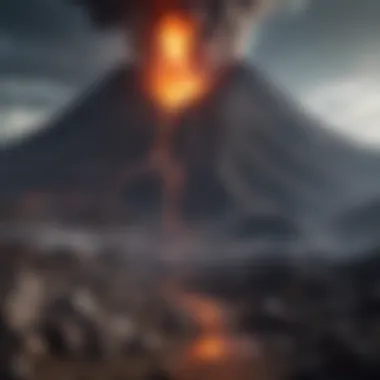

Volcanic eruptions can be classified into several types, each defined by its eruptive style and the materials expelled. Understanding these types not only helps in identifying volcanic rocks but also informs collectors about the conditions under which these rocks formed. Here’s a breakdown:
- Effusive eruptions: These eruptions involve the steady flow of lava, mainly producing basaltic rock types. The Kilauea volcano in Hawaii is prime example of this, offering a steady fountain of basalt lava.
- Explosive eruptions: Characterized by violent outbursts, these eruptions eject ash, tephra, and pumice into the atmosphere. Mount St. Helens is an iconic case of this type. These events often lead to the formation of andesite and rhyolite due to the rapid cooling of ash and fragments.
The type of eruption heavily influences the composition and characteristics of volcanic rocks, which is crucial knowledge for anyone with an interest in the intricacies of volcanic geology.
Cooling and Solidification
Once magma reaches the surface, it begins to cool and solidify, a phase that can drastically change its properties. The rate of cooling plays a critical role in determining the texture and minerals of the resulting rock. Quick cooling usually leads to fine-grained textures, as seen in volcanic glass, while slower cooling allows for larger crystal formations, resulting in rocks like obsidian.
Additionally, the environment of cooling—whether underwater, on land, or within the atmosphere—also influences the final rock type. For example, submarine eruptions typically produce pillow lavas, featuring bulbous shapes that form when lava rapidly cools upon contact with sea water. It's fascinating to consider that the tiniest differences in cooling rates and environmental conditions can lead to drastically different rock types, a significant detail for collectors aiming to distinguish between them.
"The elegance of volcanic rock formation lies not just in the materials involved but in the interplay of Earth's forces that shape our world."
In summary, the formation processes of volcanic rock—from the generation of magma to its cooling—are foundational in understanding the types of rocks present in the Earth's crust. By studying these processes, collectors and enthusiasts alike can deepen their appreciation for the natural world and the forces that continuously reshape it.
Types of Volcanic Rock
Understanding the types of volcanic rock is crucial in grasping the complexities of geological processes. Each type offers unique insights into the conditions under which it formed and the environments it inhabits. Recognizing these rocks not only helps in geological studies but also provides a lens into the past, revealing the Earth's volcanic activity and its impacts. In addition, for collectors and enthusiasts, knowing the specifics of different types enhances their appreciation and expertise in volcanic specimens.
Igneous Rocks Overview
At the core of volcanic rocks lies igneous rock, which forms from the cooling and solidification of molten material or magma. Igneous rocks are typically categorized into two main types: intrusive and extrusive. Intrusive igneous rocks, like granite, cool slowly beneath the Earth’s surface, resulting in larger crystals. In contrast, extrusive igneous rocks, including volcanic rocks, cool quickly after magma erupts onto the surface. This rapid cooling leads to finer-grained textures:
- Porphyritic Texture: Features larger crystals embedded in a finer matrix, indicating a complex cooling history.
- Glassy Texture: Exhibits no crystal structure, resulting from the quick cooling of lava, common in obsidian.
The significance of these textures can't be overstated; they provide hints about the cooling conditions and eruption processes.
Basalt: Composition and Characteristics
Basalt stands as one of the most prevalent types of volcanic rock. This dark, dense rock forms primarily from the rapid cooling of lava that is low in silica, which grants it a fluid-like behavior during eruptions. Predominantly composed of plagioclase feldspar and pyroxene, basalt features a fine-grained matrix filled with tiny crystals. What’s truly intriguing about basalt is its diverse features, which can include:
- Pahoehoe: Characterized by a smooth, undulating surface, resembling twisted braided ropes, formed by slow-flowing lava.
- A'a: Rough and jagged, this texture breaks apart rapidly as lava cools and flows energetically.
If you’ve ever encountered basalt formations or columns, you might have marveled at their appearance, often sculpted into beautiful, hexagonal shapes through cooling fractures.
Andesite and its Unique Features
Andesite sits between basalt and rhyolite in terms of silica content. It typically forms in subduction zones, where oceanic plates are thrust under continental plates, creating a unique volcanic environment. The coloration of andesite can vary from gray to greenish, owing largely to its mineral compositions, which include amphibole, biotite, and plagioclase.
One of the fascinating aspects of andesite is its association with explosive eruptions. Unlike basalt, which spills lava smoothly, andesite tends to produce violent eruptions due to its higher viscosity, trapping gas within the magma. Some observable features of andesite include:
- Porphyritic Textures: This often features larger crystals of plagioclase or hornblende set within a finer-grained matrix.
- Volcanic Breccia: This can form from brecciation processes during explosive episodes.
Rhyolite Composition and Formation
When it comes to silica-rich volcanic rocks, rhyolite takes center stage. Its high silica content gives it a thicker consistency, leading to a propensity for explosive eruptions. This rock can appear in various shades, from light-colored hues to reddish tones due to the presence of iron-rich minerals.
The formation of rhyolite generally occurs during felsic volcanic activity. This implies a slow crystallization process, often resulting in a glassy texture, indicating rapid cooling after eruptions. Notable characteristics of rhyolite include:
- Flow Banding: A feature arising from molten rock flowing and solidifying in layers, creating striking visual patterns.
- Feldspar Phenocrysts: Often prominent in the rock, offering clues to its cooling history and mineralogy.
Geological Significance of Volcanic Rock
The geological significance of volcanic rock cannot be overstated. It serves not just as a foundation stone in the earth's crust, but also as a record of the dynamic processes that shape our planet. Furthermore, these rocks provide insight into volcanic activity, which is integral to understanding the ongoing changes of the Earth’s surface. By studying volcanic rocks, geologists can piece together the various phases of the Earth's developmental narrative, highlighting key events in its history. This section delves into two crucial areas regarding the geological significance of volcanic rock.
Volcanic Rock in Plate Tectonics
Volcanic rocks are intimately tied to the dynamics of plate tectonics. They are formed primarily at boundaries where tectonic plates meet, either through divergent or convergent interactions. When these plates pull apart, magma rises to fill the gap, leading to the formation of basaltic rocks at mid-ocean ridges. In contrast, at subduction zones, the intense pressure causes magma to develop in more complex ways, resulting in andesite and rhyolite varieties.
- The distribution of volcanic rock across the globe mirrors the tectonic plate boundaries.
- Iceland, for example, stands at the juncture of two plates, showcasing rich lava fields and diverse volcanic activity.
Moreover, understanding the mineralogical composition of these rocks helps infer the conditions under which they formed. Different types of volcanic rock signify varied volcanic processes, thus helping to delineate the activity and history of tectonic interactions.
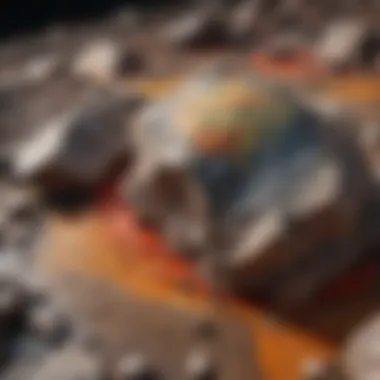
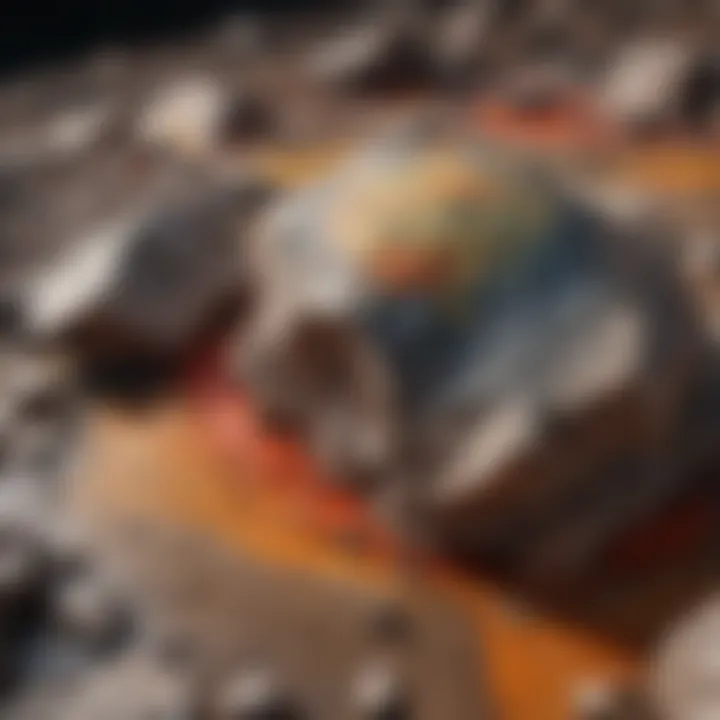
Implications for Earth’s History
The study of volcanic rock offers significant clues pertaining to Earth’s history, particularly the stories behind past climate changes, major extinction events, and continental shifts. Geological layers of volcanic activity can reveal information about periods of enhanced volcanic eruptions, which are often linked to global cooling or warming events due to the release of ash and gas into the atmosphere.
For example, the Toba supereruption approximately 74,000 years ago is believed to have caused a volcanic winter, drastically affecting climate and potentially leading to a bottleneck in human evolution. This kind of information underscores volcanic rock's role as a historical record, documenting not just the activity of volcanoes, but also the ensuing consequences on life and the environment.
"Understanding volcanic rock provides a unique window into the Earth's tumultuous past, shaping our comprehension of present and future geological phenomena."
By tracing the layers and studying volcanic rock's characteristics, researchers can construct a timeline of Earth’s climatic and geological evolution. This exploration reveals that volcanic activity has been a relentless force, influencing both ecological landscapes and the development of life itself throughout the ages.
Ecological Impact of Volcanic Rock
Understanding the ecological impact of volcanic rock goes beyond mere geological interest; it’s a pivotal topic that intertwines the earth's processes with ecosystems. Volcanic rocks shape landscapes, influence soil types, and form habitats that support diverse forms of life. This section will delve into two major aspects of ecological impact: the formation of fertile soils and the creation of unique habitats for both flora and fauna.
Influence on Soil Formation
Volcanic rocks contribute significantly to soil formation, primarily through the weathering of the minerals they contain. When these rocks break down, they release essential nutrients that enrich the soil, making it more capable of sustaining plant life. The decomposition of volcanic ash contributes to a nutrient-dense layer of soil known as andosol, characterized by its dark color and fertility. This sort of soil is found in regions like the Pacific Northwest of the United States and parts of East Africa, where recent volcanic activity has positively influenced agricultural outputs.
In agricultural practices, soils derived from volcanic materials often exhibit high cation exchange capacity. This means that the soil can hold onto nutrients more effectively, which is a boon for farmers. For example, the famous vineyards of the Etna region in Sicily thrive on the rich volcanic soil that facilitates excellent grape cultivation. Brands such as Planeta and Benanti produce wines that highlight this unique terroir.
Moreover, the mineralogical variety present in volcanic soils supports a range of crops. Plants tend to grow with more vigor and higher yields due to deeper root systems enabled by well-structured, nutrient-rich soils.
Habitat Creation for Flora and Fauna
Volcanic rocks do not merely contribute to soil formation; they also act as a canvas for diverse ecosystems. The landscapes formed by volcanic activities often lead to rich habitats that vary dramatically. For instance, the lava tubes in Hawaii serve as unique shelters for various species of plants and animals, some of which are endemic to the region. These habitats can provide nesting grounds for birds or serve as essential spots for amphibians.
The cooling lava flows create a variety of microclimates. Some areas may become wetter, while others could remain arid depending on their geographical features. This variability encourages a range of biodiversity. For instance, forests at higher elevations in volcanic regions can have different plants compared to those at lower altitudes, leading to distinct ecological niches.
"Volcanic rocks are not just remnants of fiery eruptions; they are essential to nurturing and sustaining life on earth."
In coastal areas, newly formed volcanic islands often act as stepping stones for migrating species, providing crucial breeding grounds. Birds, insects, and plant life can colonize these new landforms relatively quickly, which is especially noticeable in the Galápagos Islands. Here, the interplay between volcanic activity and ecological succession has led to the formation of unique species that are adapted to their volcanic surroundings.
In summary, the ecological impact of volcanic rock extends from the soil it creates to the habitats it forms, influencing both natural ecosystems and human endeavors. The interplay between geology and ecology paints a fascinating picture of life flourishing in what seems, at first glance, to be a barren environment.
Utilization of Volcanic Rock
Volcanic rock is not just a fascinating subject of study; it offers a variety of practical applications that have been utilized by humans throughout history. This section focuses on two key aspects of volcanic rock utilization: its role in construction and its cultural significance. Understanding these applications helps in appreciating not only the geological processes but also the intrinsic value that these rocks hold in our daily lives.
Construction Materials and Techniques
Volcanic rock, particularly basalt, is widely used in the construction industry due to its durability and unique properties. When it comes to building materials, it’s a natural choice because of its strength and resistance to weathering. Historically, structures have been built using volcanic rock, evident in ancient Roman aqueducts where tuff, a type of volcanic rock, served both aesthetic and functional purposes.
One of the most notable features of volcanic rock is its excellent thermal insulation properties. This means that buildings constructed using these materials can maintain internal temperatures more effectively, offering energy savings and a comfortable environment.
- Basalt is often processed into aggregates for concrete or used as a paving material. Streets lined with basalt cobblestones can be seen in numerous cities, showcasing both beauty and functionality.
- Pumice, another volcanic rock, is lightweight and porous, making it an ideal additive in lightweight concrete. This innovative use leads to reduced weight in buildings without sacrificing strength.
The construction techniques utilizing volcanic rock vary across cultures but share the common advantage of enhancing structural integrity. Instead of merely using bricks and mortar, many ancient civilizations incorporated volcanic rock into their architectural designs, often leading to aesthetically pleasing structures that stand the test of time.
Cultural and Symbolic Uses
Volcanic rock also finds its place in cultural practices and symbolism across different societies. In many regions, these stones are interwoven with local heritage and craft. For instance, in Pacific Island cultures, volcanic rock is not only a practical resource but also carries spiritual significance.
- Statues and Moai: The famous statues on Easter Island are carved from volcanic tuff, reflecting not only the local geology but also the cultural beliefs of the people. These structures represent ancestors and hold historical significance within the community.
- Ritual Use: In some cultures, volcanic rocks are used in traditional ceremonies, where they symbolize strength and resilience, mirroring the characteristics of volcanoes themselves.
Furthermore, artisanal crafts often utilize volcanic rock as a medium. Pottery made from volcanic ash or tools crafted from obsidian showcase the adaptability of these materials in artistic expressions. The natural beauty of these rocks, with their unique textures and colors, adds a layer of richness to cultural artifacts.
"Volcanic rock encapsulates not just a physical component of the earth's crust but carries the soul of cultures, histories, and craftsmanship that define human experience."
Overall, the utilization of volcanic rock extends beyond the base material properties, embedding itself deeply into the fabric of human civilization. Its various applications—from construction to cultural artifacts—highlight its significance both as a geological resource and as a vital part of human expression and resilience.
Volcanic Rock and Human Activity
Understanding the interplay between volcanic rock and human activity is paramount, especially as we navigate the complexities of our environment. Volcanic rock offers more than just a geological wonder; it has deep implications for human life, safety, and the very fabric of societies situated near volcanic regions. The benefits of studying this relationship extend into risk management, resource utilization, and cultural significance.
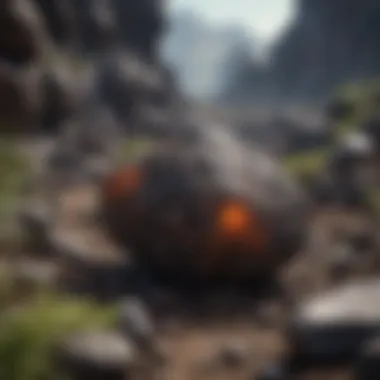
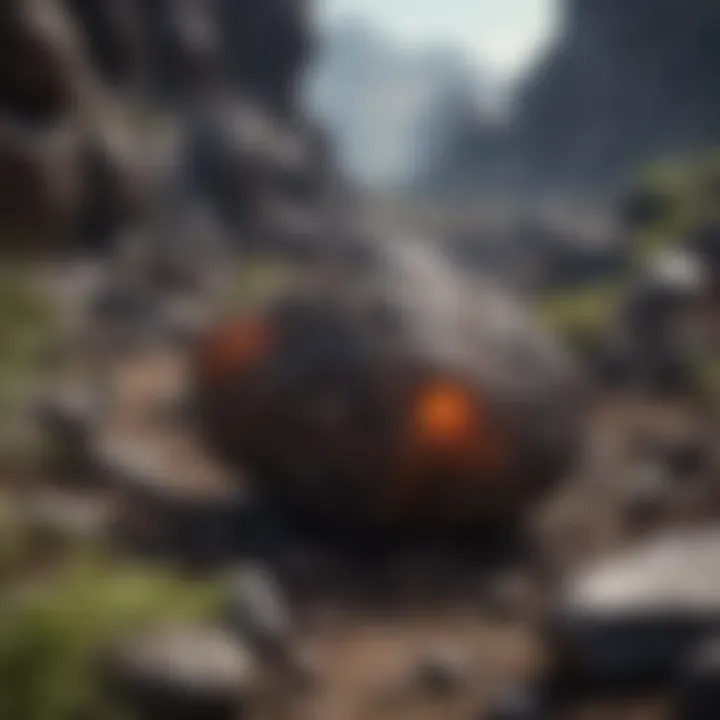
Risk Assessment of Volcanic Regions
When we discuss volcanic rocks, we cannot ignore the inherent risks tied to living near active volcanoes. These regions require meticulous monitoring to ensure the safety of their inhabitants. Volcanic eruptions, while they generate unique geological formations and enrich ecosystems over the long term, can wreak havoc in the blink of an eye. A comprehensive risk assessment is crucial.
Key considerations include:
- Eruption History: Understanding past eruptions can help predict future activity. For example, the 1980 eruption of Mount St. Helens reshaped the surrounding landscape and taught us much about volcanic behavior.
- Hazard Evaluation: Identifying neighboring communities at risk is essential. The ash fallout can affect air quality, while pyroclastic flows can devastate towns.
- Preparedness Planning: Setting up effective emergency response plans ensures communities can mitigate damage in the event of an eruption. This might include establishing evacuation routes and alert systems.
"Knowledge is power—especially for communities living in the shadows of volcanoes. "
Maintaining an ongoing dialogue between scientists and local populations is necessary to reinforce safety measures and educate residents about potential hazards.
Impact on Local Communities
The relationship between volcanic rock and local communities is deeply intricate, shaped by both challenges and opportunities. Communities in volcanic regions often have cultural identities intertwined with their geological surroundings. The very ground they walk upon informs their way of life, from agriculture to architecture.
- Economic Aspects
- Cultural Connection
- Tourism: Volcanoes attract visitors seeking adventure and education. Regions like Hawaii thrive on tourism, with attractions centered around volcanic activity.
- Mining: Some volcanic rocks contain valuable minerals, making them economically significant. The extraction of pumice, for example, shapes various industries, from construction to cosmetics.
- Traditions and Beliefs: Many cultures view volcanoes as sacred. They feature heavily in myths and legends. Consider how the volcanoes in Japan are revered, influencing everything from art to festivals.
- Community Arts: Local artisans often incorporate volcanic materials into their crafts. The unique textures and colors found in volcanic rock can inspire creativity, leading to the development of new artistic styles.
The challenges of living in these majestic yet volatile areas cannot be overlooked, but they also provide communities with a canvas for resilience and innovation. Acknowledging the way volcanic rock shapes human activity can guide future development, ensuring both safety and sustainability.
Future Research Directions
The field of volcanology continues to evolve, opening doors to fresh perspectives and methodologies that can deepen our understanding of volcanic rock. This section delves into future research directions, emphasizing emerging technologies and interdisciplinary approaches that promise to reshape the landscape of volcanic studies.
Emerging Technologies in Volcanology
With rapid advancements in technology, volcanologists are harnessing new tools that can enhance the precision of their studies. For instance, remote sensing technologies have seen significant development. Using satellite imagery and drones, researchers can monitor volcanic activity in real-time, allowing them to spot changes in surface temperature or gas emissions more efficiently than ever before.
Moreover, technologies like geophysical surveys play a crucial role in identifying subsurface structures associated with potential eruptions. Methods such as seismic tomography use waves created by earthquakes to map the magma reservoirs beneath the Earth’s surface. This tech not only aids in understanding eruption dynamics but also improves risk assessment for regions vulnerable to volcanic hazards.
One particularly intriguing tool is the implementation of machine learning algorithms. By analyzing vast datasets from previous eruptions, these systems can identify patterns and predict future volcanic events more accurately. Such predictive models could revolutionize how we prepare for volcanic eruptions, potentially saving lives and minimizing disruption to local communities.
Interdisciplinary Approaches to Volcanic Studies
In tackling complex geological phenomena, interdisciplinary approaches are increasingly recognized as vital. Integrating knowledge from fields like geochemistry, environmental science, and even anthropology enables a holistic understanding of volcanic rock and its impact.
For example, studying volcanic gases not only provides insights into volcanic processes but also informs us about their implications on climate change and air quality. Researchers are exploring the relationship between volcanic eruptions and historical climate shifts, perhaps linking past events to shifts in global temperatures.
Furthermore, incorporating social sciences into volcanic studies can clarify how communities interact with volcanic environments. Researching community preparedness, cultural beliefs, and local governance can lead to improved risk management strategies. Understanding the social context in which volcanic activity occurs can greatly impact how communities respond to eruptions.
By combining various disciplines, researchers can create more effective plans for disaster management and enhance community resilience. The synergy between disciplines enriches the exploration of volcanic rocks, making the studies not just about geology but a comprehensive understanding of human and ecological interplay.
"Research is creating new knowledge." — Neil Gaiman
The exploration of volcanic rock through these emerging technologies and interdisciplinary frameworks is crucial. It highlights the importance of adaptable approaches that can respond to growing challenges posed by active volcanoes around the globe. As every volcanic eruption tells a story — from the formation of rocks to their interactions with human societies — the future of volcanic studies is bound to illuminate many undiscovered paths.
Finale
Understanding volcanic rock is crucial for several reasons that go beyond simply appreciating its beauty or unique characteristics. Firstly, volcanic rocks, such as basalt, andesite, and rhyolite, provide a window into the Earth's past. They tell stories of geological activity, helping scientists piece together the dynamic processes that have shaped our planet over millions of years. This article has covered how these rocks form from molten magma, the different eruption styles, and how they cool and solidify.
Now, let’s recap some key insights:
Recap of Key Insights
- Volcanic rocks form mainly from the cooling and solidification of magma.
- There are various types of volcanic rock, each with its own composition and characteristics, influencing everything from soil quality to architecture.
- Studies in volcanic geology shed light on broader areas such as plate tectonics and Earth's climatic history.
- The ecological impact of these rocks is significant as they affect soil fertility and create unique habitats for various forms of life.
- Volcanic rocks also have practical applications in construction and cultural symbolism, bridging the gap between nature and human activity.
These insights underscore the multifaceted role volcanic rocks play in our understanding of the Earth.
The Ongoing Importance of Studying Volcanic Rocks
The study of volcanic rock is not just about understanding geology; it has real-world implications. For one, in volcanic regions, knowing the types of rocks present can guide risk assessments and disaster preparedness. Communities living near active volcanoes can benefit from geological studies that inform them about potential hazards. Furthermore, ongoing research in this field fosters advancements in technology and science that can be applied to other areas, including mining and environmental rehabilitation.
To encapsulate, studying volcanic rocks offers a blend of historical insight and contemporary relevance, contributing to our knowledge of Earth’s geological processes while directly impacting the safety and prosperity of communities. As we continue to explore these captivating elements of Earth, we gain not just academic knowledge, but practical understanding that helps us navigate the complexities of our environment.
Studying volcanic rocks allows us to connect the dots between the Earth's past and present, revealing deeper truths about our world.



